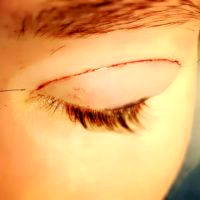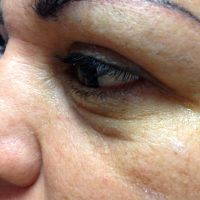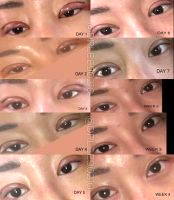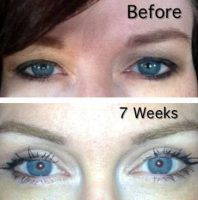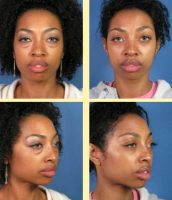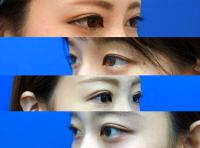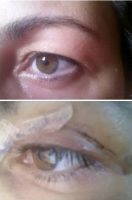Blepharoplasty Info
Blepharoplasty – surgery aimed at improving the appearance of the eyelids and periorbital area (around the eyes), by removing excess skin, partial removal or redistribution of intraorbital fat as well as tightening the circular muscles of the eye.
The eyelids and periorbital area are one of the most prone to age-related changes in the areas of the face. Very delicate skin of eyelids shows age faster than any other.
Eyes – the most colorful and expressive part of the face. However, due to aging, and partly due to a genetic predisposition, the skin under the eye area loses elasticity. An indication for blepharoplasty is not the age of the patient, but the presence of excess skin and hernias. Eyebrows lowered, upper eyelids hang in the area of the lower eyelids are formed “fat” hernias. Blepharoplasty (eyelid surgery) – a procedure by which excess skin is removed, and also removed or redistributed serving adipose tissue in the upper and lower eyelids.
The changes affect not only the skin but also deeper structures. External manifestations are: excess skin in the upper eyelids that can hang and even reduce the field of vision, in the area of lower eyelid wrinkles appear and so-called “bags” under the eyes. In such cases it is possible to improve the situation by using surgery called blepharoplasty. Aesthetic blepharoplasty – one of the most popular aesthetic surgery.
There is no specific age for blepharoplasty. Such surgery is possible to carry out both the young and the elderly. The greatest number of surgeries performed after 35 years. Skin of the eyelids is the thinnest on the surface of the human body, it gives the ability to better and more rapid healing as compared with other parts of the body.
In most cases, the scar extends along the natural crease, and it is practically impossible to discern after the procedure. Blepharoplasty helps refresh and restore youthfulness of your face by reducing the severity and sagging of eyelids, puffiness and bags under the eyes.The main indications for surgery blepharoplasty are:
- Overhang of the skin in the upper eyelids that may cause narrowing of the visual field and trouble of view;
- “Fatty hernia” of the upper eyelids;
- Ptosis (drooping) of the upper eyelids;
- Ptosis of the lacrimal glands in the area of upper eyelids;
- Excess skin of the lower eyelids;
- Wrinkles in the lower eyelids;
- Muscle weakness;
- “Eye bags”;
- Deep nasolacrimal furrows.
There are 4 types of age-related changes in the periorbital area.
Type 1 – the initial changes eyelids, with minimal muscle and skin weakness, and minor herniation.
Type 2 – to the above changes are added the excess skin in the upper and lower eyelids and the transition of age-related changes on the cheek.
Type 3 – the continuing changes in the tissues periorbital area, with overhang of eyebrow, “Skeletonization” the lower edge of the orbit, the appearance of the eyelid-cheek furrows and deepening of the nasolabial folds, wherein the excess skin more pronounced.
For each patient is selected individual technique of surgery. There are cases when in 35-40 age is simple enough remove excess fat through a transconjunctival access.
This is possible with the first type of age-related changes. For older patients with more significant changes of 2-3 type usually necessary remove excess skin and sometimes muscle, manipulation with fat, eyebrow lifting and canthopexy.
Patients with type 4 of age changes need lower blepharoplasty and midface lift. The usual result of blepharoplasty is more open, cheerful and lively look with a smaller overhang of the skin and reducing swelling around the eyes.
It is important to understand that in people with constantly arising swelling of the upper and lower eyelids, the situation can be greatly improved. However, eyelid edema may persist after surgery.It is also necessary to pay attention to the position of the eyebrows and to determine whether this is the cause of excess skin on the upper eyelids. Quite often, patients who going to do the upper eyelids surgery have drooping eyebrows. As a rule, they have no idea about this. In such cases with simple excision of the skin of the upper eyelids, achieved only short-term effect. Eyebrows descend even lower and excess skin reappears. During the consultation on the forthcoming intervention is necessary to clarify whether there are problems with the eyes. If the problem is – necessary preoperative consultation with an ophthalmologist vision test.
Upper blepharoplasty (upper eyelids surgery)
Immediately before surgery is performed preoperative marking with a certain amount of skin removed. During surgery, the surgeon removes the skin and may remove a small portion of muscle and fat. At the end of surgery are superimposed cosmetic seams.Lower blepharoplasty (lower eyelids surgery)
Before the surgery the surgeon determines whether there is excess skin on the lower eyelids, its elasticity, the presence of excess fat and tone century. If there is excess skin – is used percutaneous (transdermal) access. When using of cutaneous access an incision is made on skin, indented 3-4 mm from the ciliary edge. Adipose tissue is removed or redistributed in the lack of it. Procedures such as lifting the midface, canthopexy – and, if necessary, are made from this access. Then removed excess skin and sometimes portions of the circular muscles of the eye. On wound is applied cosmetic seam.
In the absence of excess skin is performed transconjunctival blepharoplasty. In this surgery, there is no incision in the skin. The cut of tissue is made from the inside of the eyelid. Thus there are no traces of the surgery.This surgery is effective in cases where there is excess body fat in area of upper and lower eyelids. During surgery the fat is partially removed or redistributed.
Blepharoplasty – very visual, effective and minimally invasive surgery that improves the appearance not only of eyes, but also the perception of the whole person.
Surgery time: from 30 minutes to 2 hours.
The position of the cut and the information details of the surgery: For the upper eyelid incision is performed on the crease; for the lower eyelid incision runs right under the eyelashes or the inside of the eyelid.
Possible Side Effects: Temporary discomfort in the eyes, swelling and bruising. Tearing and sensitivity to light may be within the first week.
Risks: Infectious complications, bleeding, dry eye, eye asymmetry, the impossibility of a complete closure of the eyelids.
Recovery: During the first week is not recommended overly strain your eyes (much to read, watch TV, work on the computer). The stitches on the eyelids are removed on day 4-5. On work you can come back after 1 week. After 3 weeks after the operation is allowed to resume the previous physical activity. Swelling and bruising usually disappear within 7 – 14 days.
Result: From several years to long term, depending upon the rate of aging and predisposing of patient.
Blepharoplasty Eye Wiki:
- Question You Need To Ask Undergoing Upper Eyelid Surgery There are many surgical cosmetic procedures that are frequently performed, and one of these procedures is the upper eyelid surgery. This surgery is used to eliminate accumulated fat deposits, drooping, and loose skin that occur...read more
- Cost Of Laser Blepharoplasty The price for laser blepharoplasty varies from 3000 to 5000 US dollars. Laser Blepharoplasty is a confusing term because it does not describe what is being done with the laser. Similarly, what is traditional Blepharoplasty?...read more
- Blepharoplasty Suture Removal Blepharoplasty is a delicate surgical procedure, and the incisions are closed with delicate sutures. Most commonly, the ends of the sutures are held down to the skin at the nasal bridge and at the corner...read more
- Weight In Eyelid Surgery If you desire to lose weight it is always better to lose the weight prior to surgery if your reason and method for weight loss is wellness. Taking diet pills or other drastic methods will...read more
- Blepharoplasty Young Patients Upper Eyelid Surgery for 18 year old Age 18 is not too young for upper eyelid blepharoplasty so long as there is an appropriate anatomic condition to correct. Most young patients may have a genetic...read more
- Asymmetrical Eyes After Blepharoplasty At just over two weeks after Blepharoplasty surgery, it is normal to have some asymmetry. This may affect both the skin and the fat of the lower eyelids, and may also affect the shape of...read more
- Facelift With Blepharoplasty Facelift with blepharoplasty can be performed together at the same time under one anesthetic with one recovery period. Performing 2 surgeries will cost more, because of the cost of the operating room and anesthesia. If...read more
- Wrinkles After Blepharoplasty Wrinkling under eyelid Wrinkles under the eyelid are not necessarily treated by a lower eyelid blepharoplasty. The fine lines and wrinkles are often treated with a skin resurfacing procedure such as a chemical peel or...read more
- Upper Blepharoplasty Complications Upper eyelid surgery is very safe. It can be performed in the office under local anesthesia without any sedation or general anesthesia and typically takes about 30 minutes. With that said, the photos you submit...read more
- Lower Blepharoplasty For Wrinkles Under Eye Wrinkle Treatment with Blepharoplasty I agree that if the area under the eyes has fat bags and loose skin then a lower blepharoplasty must be performed either by transconjunctival or external approach. For...read more
- Dry Eyes After Blepharoplasty It is quite common to have some dry eye symptoms after an eyelid lift (blepharoplasty). The inflammation after surgery can lead to reduced tear production and dry eyes. This is temporary in the vast majority...read more
- Anesthesia For Blepharoplasty Surgery Anesthesia for eyelid surgery Most commonly, we perform eyelid surgery with sedation and local anesthesia. IV drugs are given to make you comfortable (Fentanyl and Versed are common), then a short acting drug (Propofol, remifentanyl,...read more
- Eyelid Asymmetry Treatment Asymmetry of the eyes and orbit are extremely common and when looked at closely, most people have some asymmetry. In your case, asymmetry is present although it’s relatively minor. I would not recommend treatment for...read more
- Eyebrow Lift Using Botox Nonsurgical eyebrow lift in young patients I would urge you to avoid any surgery at this point (I think your instinct against surgery at this point is a wise one) and the nonsurgical treatments are...read more
- Blepharoplasty Insurance Coverage In some cases, health insurance companies will provide coverage for a blepharoplasty if the upper eyelid skin is so redundant that it obstructs your peripheral vision It does require a thorough examination by a surgical...read more
